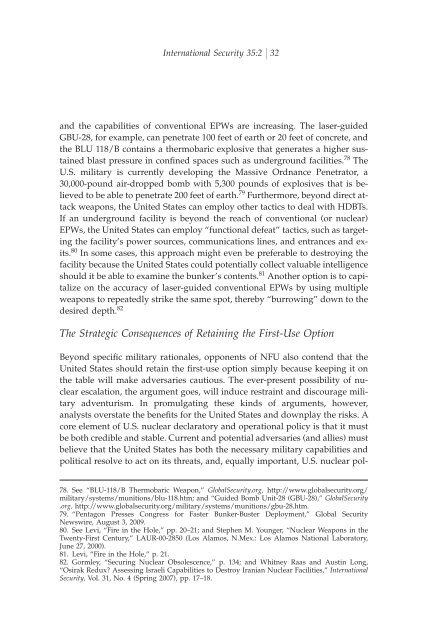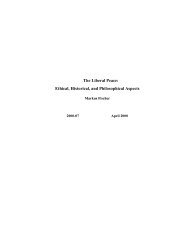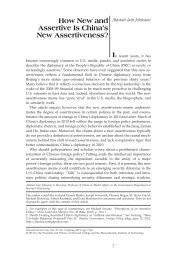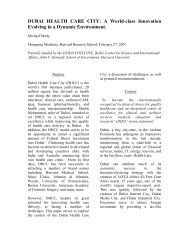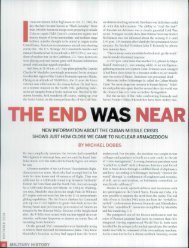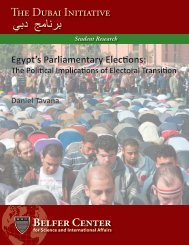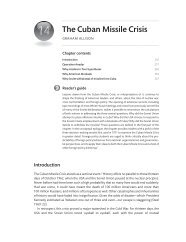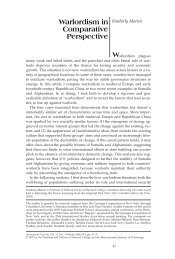The Next Step for U.S. Nuclear Policy - Project MUSE
The Next Step for U.S. Nuclear Policy - Project MUSE
The Next Step for U.S. Nuclear Policy - Project MUSE
You also want an ePaper? Increase the reach of your titles
YUMPU automatically turns print PDFs into web optimized ePapers that Google loves.
International Security 35:2 32<br />
and the capabilities of conventional EPWs are increasing. <strong>The</strong> laser-guided<br />
GBU-28, <strong>for</strong> example, can penetrate 100 feet of earth or 20 feet of concrete, and<br />
the BLU 118/B contains a thermobaric explosive that generates a higher sustained<br />
blast pressure in conªned spaces such as underground facilities. 78 <strong>The</strong><br />
U.S. military is currently developing the Massive Ordnance Penetrator, a<br />
30,000-pound air-dropped bomb with 5,300 pounds of explosives that is believed<br />
to be able to penetrate 200 feet of earth. 79 Furthermore, beyond direct attack<br />
weapons, the United States can employ other tactics to deal with HDBTs.<br />
If an underground facility is beyond the reach of conventional (or nuclear)<br />
EPWs, the United States can employ “functional defeat” tactics, such as targeting<br />
the facility’s power sources, communications lines, and entrances and exits.<br />
80 In some cases, this approach might even be preferable to destroying the<br />
facility because the United States could potentially collect valuable intelligence<br />
should it be able to examine the bunker’s contents. 81 Another option is to capitalize<br />
on the accuracy of laser-guided conventional EPWs by using multiple<br />
weapons to repeatedly strike the same spot, thereby “burrowing” down to the<br />
desired depth. 82<br />
<strong>The</strong> Strategic Consequences of Retaining the First-Use Option<br />
Beyond speciªc military rationales, opponents of NFU also contend that the<br />
United States should retain the ªrst-use option simply because keeping it on<br />
the table will make adversaries cautious. <strong>The</strong> ever-present possibility of nuclear<br />
escalation, the argument goes, will induce restraint and discourage military<br />
adventurism. In promulgating these kinds of arguments, however,<br />
analysts overstate the beneªts <strong>for</strong> the United States and downplay the risks. A<br />
core element of U.S. nuclear declaratory and operational policy is that it must<br />
be both credible and stable. Current and potential adversaries (and allies) must<br />
believe that the United States has both the necessary military capabilities and<br />
political resolve to act on its threats, and, equally important, U.S. nuclear pol-<br />
78. See “BLU-118/B <strong>The</strong>rmobaric Weapon,” GlobalSecurity.org, http://www.globalsecurity.org/<br />
military/systems/munitions/blu-118.htm; and “Guided Bomb Unit-28 (GBU-28),” GlobalSecurity<br />
.org, http://www.globalsecurity.org/military/systems/munitions/gbu-28.htm.<br />
79. “Pentagon Presses Congress <strong>for</strong> Faster Bunker-Buster Deployment,” Global Security<br />
Newswire, August 3, 2009.<br />
80. See Levi, “Fire in the Hole,” pp. 20–21; and <strong>Step</strong>hen M. Younger, “<strong>Nuclear</strong> Weapons in the<br />
Twenty-First Century,” LAUR-00-2850 (Los Alamos, N.Mex.: Los Alamos National Laboratory,<br />
June 27, 2000).<br />
81. Levi, “Fire in the Hole,” p. 21.<br />
82. Gormley, “Securing <strong>Nuclear</strong> Obsolescence,” p. 134; and Whitney Raas and Austin Long,<br />
“Osirak Redux? Assessing Israeli Capabilities to Destroy Iranian <strong>Nuclear</strong> Facilities,” International<br />
Security, Vol. 31, No. 4 (Spring 2007), pp. 17–18.


